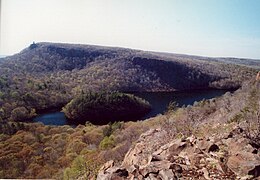| Hanging Hills | |
|---|---|
| Metacomet Ridge | |
 View of East Peak and Castle Craig from South Mountain, with Merimere Reservoir and Mine Island visible below | |
| Highest point | |
| Peak | West Peak |
| Elevation | 1,024 ft (312 m) |
| Dimensions | |
| Length | 3 mi (4.8 km) east-west |
| Geography | |
 | |
| Country | United States |
| State | Connecticut |
| Range coordinates | 41°33.45′N 72°49.4′W / 41.55750°N 72.8233°W |
| Geology | |
| Age of rock | Triassic and Jurassic |
| Type of rock | fault-block, igneous and sedimentary |
The Hanging Hills of south central Connecticut, United States, are a range of mountainous trap rock ridges overlooking the city of Meriden and the Quinnipiac River Valley 900 feet (274 m) below. They are a subrange of the narrow, linear Metacomet Ridge that extends from Long Island Sound near New Haven, Connecticut, north through the Connecticut River Valley of Massachusetts to the Vermont border. The range is also a subrange of the Appalachian Mountains. A popular outdoor recreation resource, the range is known for its microclimate ecosystems, rare plant communities, and expansive views from cliffs that rise abruptly over 700 feet (213 m) above the surrounding landscape.[1] The Hanging Hills encompass the 1,800-acre (7.3 km2) Hubbard Park, designed with the help of landscape architect Frederick Law Olmsted.[2] The 51 mile (80k) Metacomet Trail traverses the range.
- ^ Farnsworth, Elizabeth J. (2004) "Metacomet-Mattabesett Trail Natural Resource Assessment." Archived 2007-08-07 at the Wayback Machine. Retrieved November 20, 2007.
- ^ "Hubbard Park Hiking Trails" (PDF). Meriden Land Trust. Archived from the original (PDF) on April 12, 2012. Retrieved March 5, 2012.